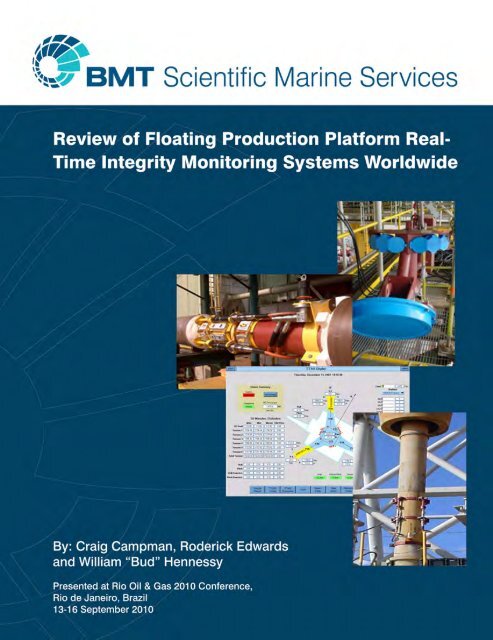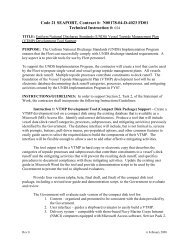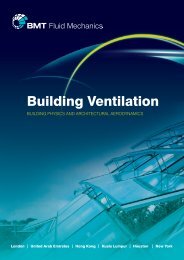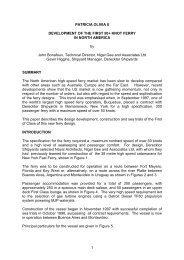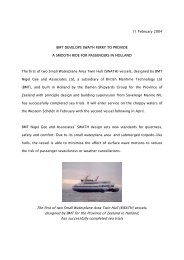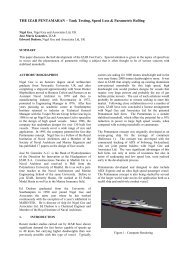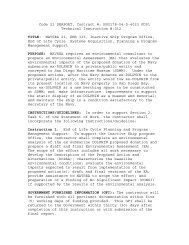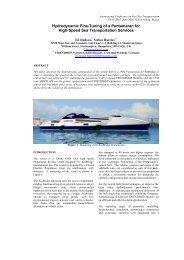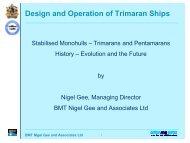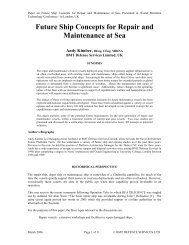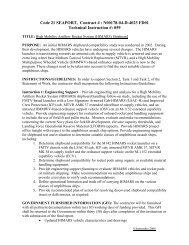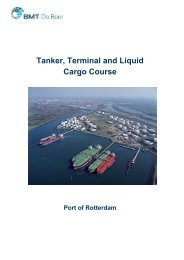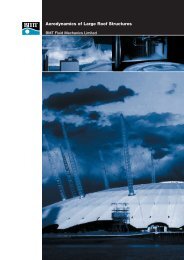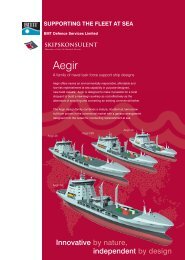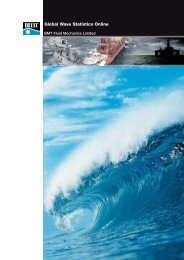Integrated Marine Monitoring System - BMT Group
Integrated Marine Monitoring System - BMT Group
Integrated Marine Monitoring System - BMT Group
Create successful ePaper yourself
Turn your PDF publications into a flip-book with our unique Google optimized e-Paper software.
IBP3407_10<br />
REVIEW OF FLOATING PRODUCTION PLATFORM REAL-TIME<br />
INTEGRITY MONITORING SYSTEMS WORLDWIDE<br />
Craig Campman 1 , Roderick Edwards 2 , William “Bud” Hennessy 3<br />
IBP3407_10<br />
Copyright 2010, Brazilian Petroleum, Gas and Biofuels Institute - IBP<br />
This Technical Paper was prepared for presentation at the Rio Oil & Gas Expo and Conference 2010, held between September, 13-<br />
16, 2010, in Rio de Janeiro. This Technical Paper was selected for presentation by the Technical Committee of the event according to<br />
the information contained in the abstract submitted by the author(s). The contents of the Technical Paper, as presented, were not<br />
reviewed by IBP. The organizers are not supposed to translate or correct the submitted papers. The material as it is presented, does<br />
not necessarily represent Brazilian Petroleum, Gas and Biofuels Institute’ opinion, nor that of its Members or Representatives.<br />
Authors consent to the publication of this Technical Paper in the Rio Oil & Gas Expo and Conference 2010 Proceedings.<br />
Abstract<br />
A technical description of environment, response and integrity monitoring systems that are currently deployed<br />
on floating production platforms offshore Brazil, West Africa, Malaysia, and in the Gulf of Mexico is presented. The<br />
rationale for making each of the measurements and the measurement approach is described. The paper summarizes the<br />
system capabilities, describes the measurements and sensors, as well as discussing the presentation of the real-time<br />
information to the production operators, and the analysis options for the stored data collected by the systems. In<br />
addition to offshore data collection, an automated onshore data transfer, data management, and analysis capabilities are<br />
presented. Selected, noteworthy, measurement technologies are discussed including very high accuracy motion<br />
measurement systems for low motion platforms, high resolution/band width riser tension and bending moment sensing<br />
systems, tendon tension monitoring, SCR top static and dynamic response measurement, wave measurement from<br />
platforms and current profiling from the platforms. Shore-side networking with the offshore monitoring systems is also<br />
described, and automated daily reports and monthly reports from these platforms are presented.<br />
<strong>System</strong>s profiled will range from the first application of this technology in the Gulf of Mexico in 1987, through<br />
mooring monitoring systems installed offshore Brazil starting in 2001, to more recent installations on facilities<br />
worldwide.<br />
The focus of the discussions of this paper will be on “marine” monitoring systems on platforms with which<br />
<strong>BMT</strong> has had sufficient involvement to permit the authors to speak knowledgeably about their particulars. Topics to be<br />
covered in the paper will include:<br />
• Objectives of the IMMS/ <strong>System</strong>s – <strong>System</strong>s that monitor “marine” parameters as distinct from drilling<br />
system parameters or process control parameters. They provide real –time operational decision support<br />
and archived data on a common time base for integrity management, forensic analysis, and verification of<br />
engineering design tools.<br />
• Operational Decision Support - The primary function of these systems is to provide real-time information<br />
in an easy to understand format to the platform operators.<br />
• Forensic Engineering - The process of establishing the cause of accidents, equipment failures, storm<br />
damage, lower than expected subsystem performance and identifying remedial action.<br />
• Integrity <strong>Monitoring</strong> - Maintain a continuous, real time picture shore side of the “health” of critical<br />
elements of the facility.<br />
• Evaluation of the impact of episodic events.<br />
• Support estimates of the remaining fatigue life in facility components.<br />
Discussion of various monitoring system components will describe the sensor types and measurements<br />
recorded in the systems installed offshore. Measurements discussed will include:<br />
• Wave Estimation—air gap measurement subsystem.<br />
• Current <strong>Monitoring</strong> - surface to platform keel, platform mounted deep profiles, and bottom current<br />
profiles.<br />
• Riser Top Tension Measurement Sub <strong>System</strong><br />
______________________________<br />
1 Senior Project Mgr., Instrumentation <strong>System</strong>s – <strong>BMT</strong> SCIENTIFIC MARINE SERVICES<br />
2 Vice President Business Development – <strong>BMT</strong> SCIENTIFIC MARINE SERVICES<br />
3 Vice President – Instrumentation <strong>System</strong>s – <strong>BMT</strong> SCIENTIFIC MARINE SERVICES
1. Introduction<br />
Rio Oil & Gas Expo and Conference 2010<br />
We shall discuss monitoring systems, the primary purposes of which are to provide information support to<br />
platform operators and to facilitate long term integrity monitoring of the “marine” systems. The first such system in<br />
which the personnel of <strong>BMT</strong> Scientific <strong>Marine</strong> Services Inc were involved was for the CONOCO Joliet TLWP in 1987.<br />
This is described in Peters D.J.H et al 1990 [1]. Since that time, these systems have evolved into comprehensive<br />
packages with operator friendly, real time features in addition to reliable archiving of data for later analysis and realtime<br />
connections to the shore. Shell Oil Company followed the Joliet Performance <strong>Monitoring</strong> <strong>System</strong> with the ground<br />
breaking Auger Performance <strong>Monitoring</strong> Instrumentation <strong>System</strong> described by Denison et al 1990 [2]. Subsequent Shell<br />
TLPs (Mars, Ram Powell, Ursa, and Brutus) were equipped with similar systems that were somewhat reduced in scope.<br />
The focus of the discussions of this paper will be on “marine” monitoring systems on platforms that have been<br />
installed since 1997 and with which <strong>BMT</strong> has had sufficient involvement to permit the authors to speak knowledgeably<br />
about their particulars. We shall refer to these systems collectively henceforth as <strong>Integrated</strong> <strong>Marine</strong> <strong>Monitoring</strong> <strong>System</strong>s<br />
(IMMS). Tables 1, 2 and 3 list the platforms in the Gulf of Mexico, Offshore West Africa, Brazil and Malaysia that will<br />
be discussed in this paper. The tables identify the platforms by name, owner, location, and/or main contractor for the<br />
design, and summarizes the measurements that are made on these platforms. These tables have been expanded to<br />
include new installations worldwide since the publication of Edwards, R.Y.et al 2005 [3].<br />
Table 1. Summary Table of Gulf of Mexico Floating Production Platforms equipped with <strong>BMT</strong> <strong>Integrated</strong> <strong>Marine</strong><br />
<strong>Monitoring</strong> <strong>System</strong>s – Part 1<br />
US Domestic<br />
Measurement Subsystem<br />
Owner/<br />
Contractor/Location<br />
Name/Type<br />
Anadarko<br />
Independence Hub (Semisubmersible)<br />
Anadarko<br />
Marco Polo (TLP)<br />
Anadarko<br />
NEPTUNE (Spar)<br />
Anadarko/Technip<br />
Boomvang (Truss Spar)<br />
Air Gap/Waves X (4) X (3) X (2) X (4) X (2) X (2) X (2) X (4) X (4) X (2) X (4) X (4) X (4)<br />
Wave Direction X<br />
Wind Speed and Direction X (2) X (2) X (2) X (2) X (2) X (2) X (2) X (2) X (2) X (2) X (2) X (2) X (3)<br />
"Surface Current" X (2) X X X (2) X X X X X X<br />
Current Profile X X X X X X X X X X X<br />
Pressure/Temperature/Humidity X X X X X X X X X X<br />
Platform Attitude and Motions (0.01 Hz -1Hz) X X X X* X X X X X X X X X<br />
X (2<br />
DOF)<br />
X<br />
Platform Position and Motions (0.00 Hz -0.01Hz)-within 190<br />
Nautical Miles of USCG Stations<br />
X X (2) X X X X (2) X (2) X (2) X<br />
Platform Position and Motions (0.00 Hz -0.01Hz)-beyond<br />
190 Nautical Miles of USCG Stations<br />
X (2) X X (2) X (2) X (2) X X<br />
Platform True Heading X X X X X X<br />
Production Riser Tensions and Bending Moments (Integral<br />
Air Can )<br />
Production Riser Tensions and Bending Moments ("Free"<br />
Air Can )<br />
X X X X<br />
Production Riser Tensions (Hydro-pnuematic Tensioners) X X<br />
Production Riser Stroke<br />
Riser and Pull Tube <strong>Monitoring</strong><br />
X (15) X (4) X (4)<br />
Air Can Buoyancy Force X<br />
Air Can Riser Guide Compression X<br />
Tendon Tensions (TLP's only) X<br />
Steel Catenary Riser Inclination/Vibration<br />
Fiber Optic Long Base Strain Gauges<br />
X X X<br />
Hybrid Riser Tower <strong>Monitoring</strong> <strong>System</strong><br />
Calm Buoy/OOL <strong>Monitoring</strong> <strong>System</strong><br />
X X<br />
Ballast Control <strong>System</strong> X X X<br />
Independent Remote <strong>Monitoring</strong> <strong>System</strong> (IRMS) X X X X X X X X X X X X<br />
Mooring Line Tensions X X X X X X X X X X X<br />
Draft X X X X X X X X X X X X X<br />
Ballast Tank Levels X X X X X X X X X X X X<br />
Anadarko/Technip<br />
Gunnison (Truss Spar)<br />
Anadarko/Technip<br />
Nansen (Truss Spar)<br />
Anadarko/Technip<br />
Red Hawk (Cell Spar)<br />
Gulf of Mexico<br />
TLP - Seastar<br />
Gulf of Mexico<br />
Semisubmersible<br />
Gulf of Mexico<br />
Semisubmersible<br />
BP/Technip<br />
Holstein (Truss Spar)<br />
BP/Technip<br />
Horn Mountain (Truss Spar)<br />
BP/Technip<br />
Mad Dog (Truss Spar)<br />
BP/ABBL G<br />
Mariin (TLP)<br />
Gulf of Mexico<br />
Semisubmersible<br />
2
Rio Oil & Gas Expo and Conference 2010<br />
Table 2. Summary Table of Gulf of Mexico Floating Production Platforms equipped with <strong>BMT</strong> <strong>Integrated</strong> <strong>Marine</strong><br />
<strong>Monitoring</strong> <strong>System</strong>s – Part 2<br />
US Domestic<br />
Measurement Subsystem<br />
Owner/<br />
Contractor/Location<br />
Name/Type<br />
Gulf of Mexico<br />
Semisubmersible<br />
Chevron/Spartec<br />
Genesis (Classic Spar)<br />
Gulf of Mexico<br />
Spar<br />
Air Gap/Waves X (4)<br />
X-laser<br />
(1)<br />
X (4)<br />
X<br />
(2)<br />
X (2) X (2) X(2) X (2) X (2) X (4) X (2)<br />
Wave Direction X X X<br />
Wind Speed and Direction X (2) X (2) X (2) X X X X X (2) X X (2) X (2) X (2) X (2)<br />
"Surface Current" X X X X (2) X X<br />
Current Profile X X X X X X X X X X X<br />
Pressure/Temperature/Humidity X X X X X X X X X X X X X<br />
Platform Attitude and Motions (0.01 Hz -1Hz) X X X X<br />
Platform Position and Motions (0.00 Hz -0.01Hz)-within 190<br />
Nautical Miles of USCG Stations<br />
Platform Position and Motions (0.00 Hz -0.01Hz)-beyond<br />
190 Nautical Miles of USCG Stations<br />
X<br />
Chevron/Atlantia<br />
Typhoon (TLP-Seastar)<br />
Conoco/COP JIP<br />
Joliet (TLWP)<br />
ENI/Atlantia<br />
Allegheny (TLP-Seastar)<br />
X (5<br />
DO<br />
F)<br />
X<br />
(2)<br />
ENI/Atlantia<br />
Morpeth (TLP-Seastar)<br />
X (5<br />
DOF)<br />
ENI/McDermott<br />
Devils Tower (Truss Spar)<br />
Gulf of Mexico<br />
Opti<br />
Murhpy/McDermott<br />
Front Runner(Truss Spar)<br />
Gulf of Mexico<br />
Semisubmersible<br />
Murphy/McDermott<br />
Medusa (Truss Spar)<br />
Gulf of Mexico<br />
Spar<br />
X X X X X<br />
W&T/Atlantia<br />
Matterhorn (TLP-Seastar)<br />
X (3<br />
DOF)<br />
X (2) X X X X<br />
X X X X X<br />
Platform True Heading X X X X X<br />
Production Riser Tensions and Bending Moments (Integral<br />
Air Can )<br />
X<br />
Production Riser Tensions and Bending Moments ("Free"<br />
Air Can )<br />
X X X<br />
Production Riser Tensions (Hydro-pnuematic Tensioners) X<br />
Production Riser Stroke X<br />
Riser and Pull Tube <strong>Monitoring</strong><br />
Air Can Buoyancy Force<br />
Air Can Riser Guide Compression<br />
X<br />
Tendon Tensions (TLP's only)<br />
Steel Catenary Riser Inclination/Vibration<br />
Fiber Optic Long Base Strain Gauges<br />
Hybrid Riser Tower <strong>Monitoring</strong> <strong>System</strong><br />
Calm Buoy/OOL <strong>Monitoring</strong> <strong>System</strong><br />
Ballast Control <strong>System</strong><br />
Independent Remote <strong>Monitoring</strong> <strong>System</strong> (IRMS)<br />
X X X X X<br />
Mooring Line Tensions X X X X X X X X<br />
Draft X X X X X X X X X X X<br />
Ballast Tank Levels X X X X X X X X X X<br />
X (MS-<br />
860)<br />
3
Rio Oil & Gas Expo and Conference 2010<br />
Table 3. Summary Table of Floating Production Platforms in Brazil, Malaysia, and West Africa, equipped with<br />
<strong>BMT</strong> <strong>Integrated</strong> <strong>Marine</strong> <strong>Monitoring</strong> <strong>System</strong>s<br />
International<br />
Measurement Subsystem<br />
2. Objectives of the IMMS<br />
Owner/<br />
Contractor/Location<br />
Name/Type<br />
Air Gap/Waves<br />
Wave Direction<br />
X (2) X (4) X (4) X (2) X (2)<br />
Wind Speed and Direction X (2) X (2) X (2) X (2) X (2)<br />
"Surface Current" X (2) X (2) X (2) X (2) X (2)<br />
Current Profile X X X X<br />
Pressure/Temperature/Humidity X X X X X<br />
Platform Attitude and Motions (0.01 Hz -1Hz) X X X X X X<br />
Platform Position and Motions (0.00 Hz -0.01Hz)-within 190<br />
Nautical Miles of USCG Stations<br />
X<br />
Platform Position and Motions (0.00 Hz -0.01Hz)-beyond<br />
190 Nautical Miles of USCG Stations<br />
X X X X X<br />
Platform True Heading X X X<br />
Production Riser Tensions and Bending Moments (Integral<br />
Air Can )<br />
Production Riser Tensions and Bending Moments ("Free"<br />
Air Can )<br />
Production Riser Tensions (Hydro-pnuematic Tensioners)<br />
Production Riser Stroke<br />
Riser and Pull Tube <strong>Monitoring</strong><br />
Air Can Buoyancy Force<br />
Air Can Riser Guide Compression<br />
X X<br />
Tendon Tensions (TLP's only)<br />
Steel Catenary Riser Inclination/Vibration<br />
X X<br />
Fiber Optic Long Base Strain Gauges X<br />
Hybrid Riser Tower <strong>Monitoring</strong> <strong>System</strong> X X<br />
Calm Buoy/OOL <strong>Monitoring</strong> <strong>System</strong><br />
Ballast Control <strong>System</strong><br />
Independent Remote <strong>Monitoring</strong> <strong>System</strong> (IRMS)<br />
X<br />
Mooring Line Tensions X X X X<br />
Draft X X X X<br />
Ballast Tank Levels X X X X<br />
<strong>Integrated</strong> <strong>Marine</strong> <strong>Monitoring</strong> <strong>System</strong>s (IMMS) monitor “marine” parameters as distinct from Drilling <strong>System</strong><br />
parameters or Process Control parameters. They provide real-time operational decision support and archived data on a<br />
BP<br />
Greater Plutonio (FPSO)<br />
West Africa<br />
TLP<br />
West Africa<br />
TLP<br />
Malaysia<br />
Truss Spar<br />
Petrobras<br />
P-52 (FPSO)<br />
Husky/SBM-A<br />
White Rose (FPSO)<br />
Petrobras/SBM<br />
Espadarte (FPSO)<br />
4
Rio Oil & Gas Expo and Conference 2010<br />
common time base for integrity management, forensic analysis, and verification of engineering design tools. The<br />
rationale for the measurement systems included in an IMMS are summarized in Table 4 and discussed in general terms<br />
in the following sections.<br />
3. Operational Decision Support<br />
Table 4. Overview of the Rationale for IMMS Measurements<br />
Operational Decision Support<br />
Measurement Subsystem Installation Running Riser Drilling Production<br />
Air Gap/W aves Not Functional Guidance on managing service vessel, crane and heavy lift operations<br />
W ave Direction Not Functional Guidance on managing service vessel, crane and heavy lift operations<br />
W ind Speed and Direction Not Functional<br />
"Surface Current"<br />
Current Profile<br />
Bottom Current (Profile)<br />
Guidance on managing<br />
service vessel operations<br />
Guidance on managing<br />
subsea operations<br />
Guidance on managing<br />
subsea operations<br />
Pressure/Temperature/Humidity Not Functional<br />
Platform Attitude and Motions (0.0<br />
and 0.01 Hz -1Hz)<br />
Platform Position and Motions (0.00<br />
Hz -0.01Hz)-within 150 Nautical Miles<br />
of USCG Stations<br />
Platform True Heading (Low<br />
frequency yaw)<br />
Production Riser Tensions and<br />
Bending Moments<br />
TLP- check trim and list<br />
prior to tendon lock-off to<br />
ensure platform installed<br />
level<br />
Check Mooring Set Up<br />
and on SCR's to verify<br />
installed angle<br />
Check As Installed<br />
Heading and on SCR's to<br />
verify installed angle<br />
Guidance on managing Helicopter,service vessel, crane and heavy lift<br />
operations<br />
Identify excessive<br />
currents<br />
Identify excessive<br />
currents<br />
Not Functional Set Riser Tension<br />
Guidance on managing service vessel operations<br />
Identify excessive<br />
currents<br />
Identify excessive<br />
currents<br />
Forensic<br />
Engineering<br />
Estimate Run-Up; Assess<br />
wave damages;<br />
Characterize environment<br />
Estimate Run-Up; Assess<br />
wave damages;<br />
Characterize environment<br />
Assess Topsides<br />
damage;Characterize<br />
environment<br />
evaluate cause of mooring<br />
failures or observed platform<br />
Vortex Induced Motion<br />
Verification of Design<br />
Tools<br />
Characterize Environmental forcing<br />
functions<br />
Characterize Environmental forcing<br />
functions<br />
Characterize Environmental forcing<br />
functions<br />
Characterize Environmental forcing<br />
functions-Validate Hull VIM Models<br />
Integrity<br />
<strong>Monitoring</strong><br />
Input to Damage<br />
Prediction Models<br />
Input to Damage<br />
Prediction Models<br />
Input to Damage<br />
Prediction Models<br />
Input to Damage<br />
Prediction Models<br />
The primary function of an <strong>Integrated</strong> <strong>Marine</strong> <strong>Monitoring</strong> <strong>System</strong> is to provide real-time information in an<br />
easy to understand format to the platform operators. The system provides “feedback” in a form and in a time frame that<br />
permits the operators to evaluate the impact of their actions on important platform responses. Examples of the use of<br />
real time data are:<br />
• Production Riser Tension<br />
- Insure that the risers are properly tensioned<br />
• Production Riser Stroke<br />
- Warn the operator of a situation where the riser stroke approaches the limits of the tensioning<br />
system<br />
• Buoyancy Can Chamber Pressure<br />
- In case loss of tension is observed, identify the leaking chamber (s)<br />
• Platform Position, Mooring Line Tension and Payout<br />
- Positioning of the Spar over the subsea well heads<br />
- Warn of need for adjustment of tensions during high current events<br />
• Platform Draft, Trim and Heel, and Ballast Tank Status<br />
- Guidance for weight and ballast control to maintain platform attitude. Certain drilling and riser<br />
running operations are intolerant of excessive trim and heel of the platform<br />
• Wind Velocity and Direction, Wave Height and Barometric Pressure<br />
- Guidance for helicopter, crane and boat operations<br />
• Dynamic Tilt (Pitch and Roll)<br />
- Guidance for BOP handling operations<br />
- Guidance for heavy lifts with cranes<br />
5<br />
N/A<br />
N/A<br />
Advance storm forecasting for Helicopter,service vessel, crane and<br />
heavy lift operations<br />
Guidance on managing heavy lift operations<br />
Positioning Platform over subsea well heads<br />
Mooring Sy stem<br />
Adjustment in<br />
Anticipation of weather<br />
or high curents<br />
Positioning Platform over subsea well heads Mooring <strong>System</strong><br />
Adjustment<br />
Manage riser tension<br />
fac tor<br />
Production Riser Stroke Not Functional Not Functional N/A<br />
Air Can pressures Not Functional Set Tension<br />
Manage riser tension<br />
fac tor<br />
W arn of Approach to<br />
Stops<br />
Maintain Tension and<br />
Identify sources of leaks<br />
Air Can Riser Guide Compression Not Functional N/A N/A N/A<br />
Tendon Tensions Set Tensions N/A N/A<br />
Mooring Line Tensions and Payout Set Tensions<br />
Draft<br />
Ballast Tank Levels<br />
Steel Catenary Riser<br />
Inclination/Vibration<br />
TLP - us e to verify<br />
installed tendon tensions<br />
TLP - us e to verify<br />
installed tendon tensions<br />
Verify SCR Installed<br />
inclination<br />
Positioning over<br />
subsea wellheads<br />
Positioning over<br />
subsea wellheads<br />
Maintain Tension and<br />
W eight Distribution<br />
Tension Adjustment for<br />
high currents and<br />
Hurricanes<br />
N/A N/A Ballast/Trim/Heel Control<br />
N/A N/A Ballast Trim Heel Control<br />
N/A N/A N/A<br />
Determ ine cause of riser<br />
loads<br />
Determ ine cause of riser<br />
loads<br />
Verify hurricane/storm<br />
intensity<br />
Estimate excitation of<br />
SCR's and production risers<br />
Estimate excitation of<br />
SCR's and Production<br />
Risers, Mooring loads<br />
Estimate excitation of<br />
SCR's<br />
identfy performance<br />
problem s<br />
identify excessive riser<br />
excursions; identify failure of<br />
B Cans to slip in guides<br />
Characterize Environmental forcing<br />
of risers<br />
Characterize Environmental forcing<br />
of risers<br />
Input to Fatigue<br />
Damage Prediction<br />
Models<br />
Input to Fatigue<br />
Damage Prediction<br />
Models<br />
N/A N/A<br />
Estimate Fatigue<br />
damage in SCR's;<br />
Verify Global Motion Models<br />
Foundations of Large<br />
tanks/Derrick<br />
Quasi static loads<br />
Verify Global Motion Models; VIM<br />
on Mooring<br />
Models<br />
Equipment<br />
Verify Global Motion Models<br />
Verify Riser Responses and fatigue<br />
models<br />
Explain Tension Loss N/A<br />
Assess loads on Buoyancy<br />
Cans<br />
investigate tendon failures<br />
Identify causes of Mooring<br />
Failures and quantify timeon-link<br />
for fatigue estimation<br />
establish causes of errors in<br />
ballast control<br />
establish causes of errors in<br />
ballast control<br />
help to identify reasons for<br />
component filure or<br />
degradation<br />
Estimate excitation<br />
of SCR's<br />
Riser Fatigue<br />
Damage<br />
Verify Riser Quasi Static<br />
N/A<br />
Responses<br />
Track integrity of<br />
chambers<br />
Assess Load Estimation M odels N/A<br />
Validate Tendon Tension Estimating<br />
Models<br />
Verify Global Motion Models<br />
Required for chracterization of hull<br />
Required for chracterization of hull<br />
verify Floater Motion induced<br />
response in SCR<br />
insure that CG is<br />
within proper limits;<br />
identify degradation<br />
in tendon anchors<br />
Track mooring line<br />
fatigue damage;<br />
anchor failures<br />
Identify sinkage due<br />
to leaks/collision<br />
damage<br />
Track Intact and<br />
Damaged Stability<br />
Estimate and Track<br />
SCR Fatigue
Rio Oil & Gas Expo and Conference 2010<br />
• SCR Strains<br />
- FPS positioning for optimizing Touch Down Fatigue<br />
• Current Profiles<br />
- Guidance for ROV operation or riser mating to the subsea well heads; Satisfaction of MMS<br />
requirements for deepwater platforms<br />
4. Forensic Engineering<br />
Forensic engineering is the process of establishing the cause of accidents, equipment failures, storm damage,<br />
lower than expected subsystem performance and identifying remedial action. Permanently recorded information about<br />
the platform’s responses and the environmental parameters that influence them is essential in this process. Typical data<br />
that are essential for Forensic Engineering are:<br />
• Riser top tension and bending moment dynamic response<br />
- Identification of the need for additional centralizers or the degradation of existing ones<br />
• Mooring line tensions, payout and spar position<br />
- Detect the occurrence of and cause of line failures and anchor “dragging”<br />
- Assessment of cumulative fatigue damage to mooring components<br />
• Platform position, surge, sway, pitch, roll and yaw<br />
- Documentation of position to establish relationship to other facilities in case of platform drift off in a<br />
hurricane<br />
- Evaluate the effect of Vortex Induced Motions on Mooring and Riser Components<br />
- Estimate fatigue damage accumulation in SCRs<br />
• Platform inclination, draft and ballast levels<br />
- Investigate accidents, mishaps due to incorrect loading, collisions with service vessel causing flooding<br />
of voids<br />
• Wind speed and direction and wave height<br />
- Document the severity of intense storms which may interrupt operations or cause damage<br />
• Air Gap (Estimated wave height and period)<br />
- Document maximum water level excursion due to storms<br />
- Assess damage due to “green water” impact on topsides<br />
• SCR Top inclination and motion<br />
- Track fatigue at SCR top and of flex joint<br />
5. Integrity <strong>Monitoring</strong><br />
• Maintain a continuous, real time picture shore side of the “health” of critical elements of the “marine<br />
package” (Moorings and Tendons, intact and damaged stability, production riser fatigue life and export<br />
riser fatigue life).<br />
• Evaluation of the impact of episodic events (Hurricanes and high current events, for example) on the<br />
residual reliability of critical marine systems such as the mooring or tether system, production risers, export<br />
risers, umbilicals, drilling equipment and critical elements of the hull and topsides structure.<br />
• Maintenance of estimates of the remaining life in fatigue sensitive structures.<br />
6
6. Overview of the IMMS<br />
Figure 1 shows a schematic overview of a typical IMMS.<br />
Figure 1. Schematic of Typical <strong>BMT</strong> IMMS<br />
Rio Oil & Gas Expo and Conference 2010<br />
A typical IMMS may be comprised of the following measurement sub-systems:<br />
• Top Tensioned Riser <strong>Monitoring</strong> Sub-system<br />
- Direct top tension and bending moment measurement<br />
- Buoyancy Chamber and Stem Pressures<br />
- Measurement of pressure in the tensioning rams<br />
- Riser Stroke<br />
• Platform Position <strong>Monitoring</strong> Sub-system<br />
- Dual Redundant GPS Units with Combination UHF/Satellite antenna. Differential corrections are<br />
acquired from the U.S. Coast Guard <strong>System</strong>. (performance degrades beyond 170–180 nautical miles<br />
from stations)<br />
- Globally Corrected GPS (Commercial Correction Service)<br />
• Precision Static Inclination and Six Degree of Freedom Motion Measurement Sub-system consisting of:<br />
- Three precision angular rate sensors<br />
- Three precision linear accelerometers<br />
• Ballast, Draft and Void Leakage<br />
- Pressure sensors<br />
- Bubbler <strong>System</strong>s<br />
- Air Gap Sensors<br />
- Moisture Sensors<br />
• Meteorological <strong>Monitoring</strong><br />
- Wind Speed and Direction (dual redundant anemometers)<br />
- Air Temperature and Barometric Pressure<br />
- Wave Height and Period<br />
• Mooring Line Tension and Payout<br />
- Usually supplied by Mooring Winch Vendor<br />
7
- Tension and payout data received by IMMS via Serial Link to Winch PLC’s<br />
• Current Profiles<br />
- Surface to keel<br />
- Deep Profile (from Platform)<br />
- Lower Profile (Bottom up)<br />
• Steel Catenary Riser Flex Joint Relative Inclination (Static and Dynamic)<br />
- Subsea Static and Dynamic Inclination Measurement Units below flex joints<br />
- Same above the flex joint or inclination of the platform<br />
• Steel Catenary Riser Bending and Tension (Static and Dynamic)<br />
- Subsea Strain Measurement Units below flex joints<br />
• The IMMS Data Concentrator/Server<br />
- PC based<br />
- Networked with other Platform Control and <strong>Monitoring</strong> <strong>System</strong>s<br />
- Remote Access<br />
- Non volatile data storage<br />
• Client Data Center<br />
- Data Management, Quality Assurance and Distribution<br />
7. Description of Important Measurement Subsystems<br />
Rio Oil & Gas Expo and Conference 2010<br />
7.1 Wave Estimation – Air Gap Measurement Subsystem<br />
The ideal way to measure the wave environment that impinges on a platform is with a wave buoy. It can be<br />
placed far enough away to avoid contamination due to the waves reflected and generated by the platform. However, a<br />
wave buoy is not a suitable, low maintenance, accessible device for a long lived installation. Instead we have chosen to<br />
use a non contact, platform mounted device that measures the instantaneous distance between a suitable place on the<br />
platform and the sea surface. That distance is measured by low powered microwave radar ranging device(s). For semi<br />
submersibles and TLPs, the air gap sensors are generally located mid way between columns to minimize interference.<br />
For Spars, the air gap sensors are located as far outboard of the hull as is possible on the corners of the Cellar Deck.<br />
Three or four are recommended to facilitate corrections for reflected/and refracted waves. The time record is processed<br />
by the IMMS to correct for platform motion and to provide an estimate of the significant height and peak period of the<br />
waves. Notwithstanding the reflections from the platform, the wave height estimated by these sensors and uncorrected<br />
for reflections/refractions was found to agree quite well with a nearby NOAA Wave Buoy in hurricane conditions. A<br />
typical installation is shown in Figure 2.<br />
Figure 2. Microwave Radar Air Gap Sensor<br />
7.2 Wind Speed and Direction<br />
The measurement of wind speed and direction is very important for providing advice to helicopters and<br />
approaching service vessels and for quantifying the environmental forces on the platforms and on derricks and flare<br />
8
Rio Oil & Gas Expo and Conference 2010<br />
towers. Crane operations are susceptible to high winds and wind speed is used as a criterion for permitting crane<br />
operations. It is difficult to get uncontaminated estimates of wind speed and direction on a production platform because<br />
of the turbulence caused by flow over the bluff shapes of the platform.<br />
Furthermore, on production platforms, some structures that appear to be ideal platforms for a wind sensor, like<br />
drilling derricks, are more often than not temporary or mobile. Flare towers, another apparently ideal location, can be<br />
hazardous to the wind sensor during large volume flaring events. Therefore, we prefer to locate wind sensors on the tops<br />
of the crane A-Frames and deal with the added complication of using the crane slip rings to provide data and power<br />
transmission and measuring the heading of the crane so the wind direction estimates are always valid. Figure 3<br />
illustrates a typical anemometer installation on an offshore platform. Standard RM Young anemometers are employed.<br />
A crane azimuth sensor, shown in Figure 4, was developed to provide correction data for the anemometer. It consists of<br />
an angular encoder mechanically linking the slip ring assembly to the crane. It provides 1 degree accuracy crane<br />
heading (relative to platform North) to the IMMS. This is not suitable for a platform that may be expected to have<br />
significant yaw.<br />
Figure 3. Anemometer installed on crane top<br />
Figure 4. <strong>BMT</strong> Electro Mechanical Angular Encoder Retrofit to Crane Sliprings<br />
9
7.3 Current <strong>Monitoring</strong><br />
Three types of current monitoring will be discussed:<br />
• Current Profiles between the Surface and the bottom of the platform<br />
• Deep current profiles (below the Keel)<br />
• Deep Current Profiles from the sea floor up<br />
These options are shown schematically in Figure 5 for a semi-submersible.<br />
SEA<br />
SURFACE<br />
Water<br />
Depth<br />
approx.<br />
1900m<br />
Long range horizontal<br />
ADCP<br />
MID-DEPTH. 28 measurement<br />
bins of 16m length<br />
Riser Mounted ADCP<br />
ADCP 468m ASB<br />
LMRP Mounted ADCP<br />
ADCP 20m ASB<br />
BOP &<br />
LMRP<br />
UPPER. ADCP<br />
30m below MSL<br />
UPPER. First bin:<br />
72m below MSL<br />
MID-DEPTH. Depth of last<br />
valid bin: 924m ASB / 976m<br />
below MSL<br />
MID-DEPTH. First bin:<br />
492m ASB<br />
SEABED. Last valid bin:<br />
476m ASB<br />
SEABED. First<br />
bin: 44m ASB<br />
Rio Oil & Gas Expo and Conference 2010<br />
UPPER. 33 measurement<br />
bins of 32m length<br />
UPPER. Depth of last valid bin:1096m<br />
below MSL/ 804m ASB<br />
SEABED. 28 measurement<br />
bins of 16m length<br />
Figure 5. Example of possible options for Current <strong>Monitoring</strong> on a Semi-Submersible<br />
Surface to Platform Keel<br />
For Spars, it is very difficult to obtain an uncontaminated profile from the water surface to the bottom of the<br />
hard tank (–250 feet MSL). The flow field around the spar hull is disturbed significantly by its presence. Multiple<br />
Horizontal ADCPs that are intended to provide the current speed and direction in a river by “looking” out across the<br />
flow have been employed on numerous platforms. The range of these instruments is on the order of 200 meters. Current<br />
vectors in the plane of the device are relatively uncontaminated at or near the instrument’s extreme range. In some<br />
cases, the H-ADCPs have been installed on the hull within diver range of the surface or can be bundled with the<br />
downward looking profilers as is illustrated in Figure 6. In some cases, H-ADCPs have been installed with a small tilt<br />
to provide a profile that spans the hard tank with the full understanding that the observations from the bins close to the<br />
sensor may be contaminated by the wake of the hull. Such an installation is shown in Figure 7. For Truss Spars, the<br />
estimate of the current vectors from the hard tank to the bottom of the truss (soft tank) is less contaminated due to the<br />
sparse spacing of structural members. For TLPs and Semi Submersibles, the task of producing valid current<br />
measurements over the depth of the hull is much less difficult since the base line of the hulls are relatively shallow (50–<br />
100 feet).<br />
10
Rio Oil & Gas Expo and Conference 2010<br />
Figure 6. Combination 38 kHz ADCP Deep Profiler and 300 kHz horizontal ADCP installation on West Africa FPSO<br />
Figure 7. Upward tilted 300 kHz H-ADCP mounted on Heave Plate at approximately 300 feet below the free surface of<br />
BP’s Mad Dog spar<br />
Platform Mounted Deep Profiles<br />
The 38 kHz ADCP from RD Instruments is the sensor that provides the deepest penetration available today in<br />
a single instrument and is recommended for installation on new platforms in deep water. The range of the instrument is<br />
nominally 1000 meters.<br />
The actual vertical penetration depends upon the inclination that may be required to prevent impingement of<br />
the beams on either the hull, production risers, mooring lines, steel catenary risers or umbilicals, etc. Figure 8 shows the<br />
final result of a beam pattern interference analysis for a typical installation on a Truss Spar. The resulting tilt of the<br />
sensor is 37 degrees and the actual vertical penetration below the sensor is 700 meters. Figure 9 is a photograph of a<br />
typical deployment fixture for a 38 kHz ADCP. Another alternative is to deploy a 75 KHz ADCP looking downward<br />
from a heave plate or pontoon.<br />
Figure 8. Example of Beam Pattern Interference Analysis for 38 kHz ADCP installation<br />
11
Rio Oil & Gas Expo and Conference 2010<br />
Shipshape FPS Mounted Surface Current <strong>Monitoring</strong> <strong>System</strong>s<br />
Horizontal ADCP’s can be used to estimate surface current in the vicinity of shipshape FPSO’s but because of<br />
the interference provided by a ship shape hull, several are required on typically only one will be offering useful results<br />
depending upon the direction of the current.<br />
Figure 9. ROV Deployable HADCP on Greater Plutonio FPSO Outward Looking (Hybrid Riser Tower Acoustic<br />
Positioning <strong>System</strong> shared the Fixture with the HADCP)<br />
Bottom Current Profiles<br />
A permanent bottom founded current meter has been deployed on some of the platforms. It is shown in Figure<br />
10. It is a battery powered 75 KHz ADCP. It is mounted on a robust tripod that also contains and acoustic modem. The<br />
tripod is aligned by the ROV to “aim” the acoustic modem at one of the spare pull tubes into which a pig containing an<br />
acoustic modem has been lowered. This package has been combined with a platform mounted 75 KHz Downward<br />
looking ADCP on a heave plate and an H-ADCP—tilted slightly upward on the same heave plate (see Figure 7).<br />
Together these three packages provide full water depth coverage in the 4000 feet water depth as may be seen on an<br />
IMMS composite current screen (See Figure 11).<br />
Figure 10. Bottom Mounted 75 kHz ADCP with Acoustic Modem in approximately 4500 Feet of Water near BP’s Mad<br />
Dog spar<br />
12
Figure 11. Typical screen plot of Combined Current Profile<br />
Rio Oil & Gas Expo and Conference 2010<br />
7.3 Riser Top Tension Measurement Sub <strong>System</strong> (Buoyancy Can Supported Risers)<br />
On most Spars, each riser is supported by air or nitrogen-filled buoyancy cans, which communicate with the<br />
sea. Each of these multi-chamber buoyancy cans is integral to a stem through which the riser passes. The stem extends<br />
from just below the surface tree to the keel and is also a buoyancy chamber. The stem terminates at its top with the stem<br />
adapter. The stem adapter has been fitted to transmit the buoyancy load through three load cells into the riser top<br />
connector, providing a direct measurement of riser tension and bending moment. The arrangement is shown in a<br />
photograph in Figure 12.<br />
Figure 12. Load Cell Arrangement in TTRMS<br />
The Top Tensioned Riser <strong>Monitoring</strong> <strong>System</strong> (TTRMS) consists of three strain gage compression load cells for<br />
each riser. The load cells individually exhibit 0.25% of full scale measurement range accuracy. The style of load cell<br />
chosen for this service have been demonstrated to have less than 0.25% long term zero drift over an 8 year period. This<br />
is an important consideration because spurious drift of the load cell might be interpreted as a gradual change in<br />
buoyancy. For one riser set, the assembly of three load cells together was exposed to known riser loads up to 1500 kips.<br />
The resulting composite accuracy in the tension range of interest (600–1500 Kips) was 1% or better. The load cell strain<br />
signal is transmitted to an explosion proof enclosure installed on each riser’s work platform. In this enclosure, three<br />
strain gage interface modules are located along with three intrinsic safety barriers and three IS rated relays to provide<br />
for remote actuation of a zero simulation and a shunt calibration. Power to the modules and RS-485 signals are<br />
transmitted to the control room via two twisted pairs in the umbilical that connects the well head work platform to the<br />
spar hull.<br />
13
Rio Oil & Gas Expo and Conference 2010<br />
Bending Moment Measurement<br />
Bending moments at the top of the riser are estimated from the differences between the load cell readings and<br />
the spacing between the load cells. The bending moment calculations are made in the IMMS software in real time.<br />
Frequency Response of the Riser Tension and Bending Moment Measurements<br />
The primary function of the TTRMS is to monitor riser tension to permit setting the tension to the desired<br />
level, and to detect leakage in the buoyancy support system. These objectives can be achieved with a very low<br />
frequency response system. However, by increasing the frequency response and also maintaining a high resolution, it is<br />
possible to detect the occurrence and approximate intensity of lateral vibration of the riser (VIV). This approach was<br />
implemented on a spar and has been shown to function as expected during high current events.<br />
Riser Stroke Measurement <strong>System</strong><br />
This measurement is the vertical displacement of a riser relative to the spar hull. It serves two primary<br />
purposes. First, it provides operating personnel with a measure of riser position relative to the hull during operations<br />
where the platform is intentionally offset for work over. The measurement provides a remote indication of the distance<br />
from the upper and lower riser stops from the limit stops.<br />
Second, in conjunction with the vessel draft, measurement of the “stroke” permits establishment of the distance<br />
from the Mean Water Surface to the buoyancy chamber tops thereby providing, in conjunction with the head<br />
measurement in each buoyancy chamber, the true estimate of the air volume in each chamber. This is essential to<br />
provide a redundant estimate of total buoyant force acting on the riser.<br />
7.4 Platform Attitude and 6 Degrees of Freedom Motions<br />
Platform trim, heel, roll, pitch and three accelerations are measured using a six-degree of freedom motion<br />
package that is preferably located as close to the lateral center of gravity as is possible and on a substantial structural<br />
member that will not be expected to vibrate. The package consists of three each high precision angular rate sensors and<br />
linear accelerometers. The package also contains local signal conditioning and digitizing equipment. The analog data is<br />
filtered with high quality analog anti-alias filters. Digitization is performed with a 16 bit A to D converter. The raw<br />
outputs of the accelerometers and rate sensors are stored for later post processing. While there are commercial off the<br />
shelf packages for 6 DOF measurements including true heading, none provide direct access to the “raw” data from the<br />
precision rate sensors and accelerometers. Only the estimation of the static heel and trim and the dynamic pitch and roll<br />
is performed in real time, since it is only these parameters that are of interest to the operators. Post processing is<br />
performed on the records monthly and for special events to provide data about the platform hull angular response and<br />
linear displacements at critical locations on the platform (riser keel joint, SCR porches, compliant riser guides, drill<br />
floor etc.).<br />
7.5 Static Inclination<br />
The most accurate and robust method for measurement of static or mean inclination of a platform is the use of<br />
linear accelerometers. The output of a linear accelerometer statically tilted θ degrees in the earth's gravity field is g•sin<br />
θ. The long-term average of the accelerometer is used to estimate the inclination in the gravity field. The expected range<br />
of inclination of the spar is ± 5 degrees under the most extreme conditions. Normal day-to-day variations in tilt for a<br />
spar are less than 1 degree. To detect inclinations of this order accurately, a self-contained inclinometer based upon<br />
biaxial quartz flexure, temperature corrected linear accelerometers is used. The output of two biaxial accelerometers<br />
(one aligned with platform North (+) and one aligned with Platform West (+) is filtered in real time with 15 minute<br />
running average. This averages out the variation in acceleration due to surge, sway, pitch and roll occurring at wave<br />
periods (5 to 20 seconds), natural pitch and roll periods (50 to 60 seconds) and Hull VIV (200 seconds). The arc sine of<br />
the averaged acceleration produces an accurate but delayed estimate of static inclination.<br />
7.6 Steel Catenary Riser <strong>Monitoring</strong><br />
Static and Dynamic Inclination<br />
The comprehensive monitoring of the response of a steel catenary riser is an expensive undertaking. However,<br />
useful information can be gained from the measurement of the static and dynamic, relative, angular motion across the<br />
flex joint. This can be accomplished with measurement packages that with ROV service, can last the life of the<br />
platform. For one Spar and one Semi Submersible in the Gulf of Mexico and for one West Africa FPSO, a system has<br />
been deployed that measures the earth fixed static and dynamic inclination below the flex joint of the export riser. That<br />
system uses the hull inclination to estimate the relative inclination across the flex joint.<br />
This package is ROV retrievable and deployable. It is shown in Figure 13 and Figure 14. It is hard wired to the<br />
IMMS via an ROV mateable connector and molded Subsea cable. For situations where the inclinometer package is<br />
distant from the IMMS central computer, the processing electronics are included in the subsea package as in Figure 14.<br />
In situations where the SCR’s Flex Joint is close to the weather deck of a Semi or shipshape FPSO, it is convenient to<br />
14
Rio Oil & Gas Expo and Conference 2010<br />
eliminate the subsea electronics thereby increasing the MTBF of the submerged equipment and locating the processor<br />
on a weather deck for easy access and maintenance. This also makes the subsea package easier to service with a diver or<br />
ROV. Figure 15 shows a typical compact subsea package of the type deployed on Total’s AKPO SCVR’s and OOLs<br />
(Le-Douaron et al 2009).<br />
The system has been designed and carefully calibrated to achieve accuracy in the estimation of static and<br />
dynamic inclination of better than 0.01 degrees. To validate the performance of the package prior to deployment, it was<br />
subjected to a test wherein actual Spar inclination records were used to drive a platform on which the package was<br />
mounted. Figure 16 is an example of the test record. It can be seen that the inclinometer output tracks the imposed<br />
motion quite well. The maximum dispersion of the measured versus the imposed inclination is less than 0.01 degrees.<br />
The unit has been successfully deployed on the SCR and is producing data with extremely high accuracy and<br />
sensitivity.<br />
There are now eight of these packages in subsea service, operating essentially trouble-free for between 1 and 4<br />
years.<br />
<strong>BMT</strong> Subsea<br />
Inclinometer-in<br />
service 4 years fault<br />
free at -500 feet<br />
Figure 13. <strong>BMT</strong> High Precision Static and Dynamic Subsea Inclinometer in ROV Receptacle on Holstein Spar SCR<br />
Figure 14. <strong>BMT</strong> High Precision Static and Dynamic Subsea Inclinometer (4 Degree of Freedom Inertial Package)<br />
15
Rio Oil & Gas Expo and Conference 2010<br />
Figure 15. 4-Degree of Freedom Inertial Package for use in close proximity to Surface Processor<br />
Figure 16. Comparison of Imposed and Measured Inclination (actual spar inclination record used for test)<br />
SCR/OOL Top Strain <strong>Monitoring</strong><br />
<strong>BMT</strong> has deployed two SCR Strain <strong>Monitoring</strong> <strong>System</strong>s to date. One is located on the Gulf of Mexico Spar<br />
and the other is on the SCRs on Total’s AKPO FPSO (Le-Douaron et al 2009). The strain stations consist of four<br />
LVDT type sensors encapsulated in pressure balanced, oil filled enclosures and located at 90 degree intervals around<br />
the circumference of the pipe. The sensors are anchored at either end to custom designed, steel pipe clamps. The<br />
insulation was removed in the vicinity of each top strain station location leaving only the anti corrosion coating.<br />
Extensive tests had been conducted by <strong>BMT</strong> to demonstrate that it was possible to measure tensile strain accurately by<br />
clamping the sensors to the anti-corrosion coating rather than having to remove this important anti-corrosion layer to<br />
bare steel. The SCR strain stations are designed to provide a 20 year service life without maintenance. Hence, these<br />
strain sensors are encased in a pressure compensated bellows and interconnected with pressure balanced oil filled<br />
(PBOF) hose cabling system and diver mate-able connectors on each sensor and ROV mate-able connection to the<br />
strain station. Figure 17 shows as-installed configuration of an SCR Top Strain Station without the protective cover.<br />
16
Figure 17. SCR Top Strain Station<br />
Rio Oil & Gas Expo and Conference 2010<br />
The SCR top strain stations are connected with diver serviceable cables to three respective FPSO deck<br />
mounted DAQ units. The FPSO DAQ units digitize the analog data from the sensors stations and transmit continuously,<br />
sampled strain station to the RMS instrumentation rack located in the control room. The deck DAQs are synchronized<br />
amongst themselves by a trigger signal originating at the RMS. Figure 18 shows <strong>BMT</strong>’s Strain Sensor Assembly<br />
mounted on an SCR prior to installation offshore.<br />
Figure 18. Subsea Strain Sensing Assembly before deployment on a Spar SCR<br />
7.7 Tendon Tension Measurement<br />
Tendon tension measurements are essential for the real-time operation of a TLP to (a) maintain a continuous<br />
assessment of the integrity of the tendons and (b) to maintain control over the weight distribution of TLPs such that the<br />
TLP will be prepared to endure any reasonable combination of extreme environmental conditions without the tendons<br />
experiencing zero tension or compression or exceeding the maximum allowable tension.<br />
In Table 1, four SeaStar® Tension Leg Platforms are listed. These platforms were designed and fabricated by<br />
Atlantia Offshore Ltd. (now part of the IHC Caland <strong>Group</strong>). Each platform is fitted with a “porch” based tendon<br />
tension measurement system. The system is simple in principal. Each tendon is supported on its porch by three<br />
underwater compression load cells. Figure 19 is a photograph that shows the typical installation of a compression load<br />
cell. The load cells are supported by a heavy support ring that is embedded in the porch and which has machined<br />
recesses for the load cells. The load cells are equipped with double water barriers and there are two independent strain<br />
gage bridges for redundancy. Each of the strain circuits has a separate underwater connector and armored Subsea cable<br />
to the Signal Processing Modules in the top of the central column of the SeaStar®. The processing systems are dual<br />
redundant as well. The porch based systems permit the complete installation of the tendon tension measurement system<br />
while the TLP is in the fabrication yard. The system integrity can be checked in a flooded drydock prior to deployment.<br />
Upon arrival at the installation site, the system has a valid zero and begins to offer tension and bending data, from the<br />
17
Rio Oil & Gas Expo and Conference 2010<br />
moment the tendons apply load to the flex joint. Consequently, the system is used to control the adjustment of the<br />
tendon adjustment “nut” during installation. A typical display of tendon tension information is shown in Figure 20.<br />
Figure 19. Typical Tendon Tension Measurement <strong>System</strong> load cell installation<br />
Figure 20. Typical Tendon Tension <strong>System</strong> Display<br />
7.8 Data Acquisition, Archiving and Network Interfaces<br />
The IMMS computer processes the data from the various measurement sub-systems. It has the following<br />
functionality:<br />
• Acquire all sensor data synchronized in time stamped files<br />
• Identify and alarm malfunctioning sensors and other components in the IMMS<br />
• Provide “user friendly” and timely displays of operationally important information<br />
• Archive the measured data on a common time base<br />
• Automatically prepare daily reports and e-mail to personnel who are cognizant on and off the platform<br />
• Provide requested data to other process control networks on the platform<br />
• Provide real time access to the IMMS from shore side work stations via an Internet Connection<br />
A typical IMMS collects raw data from 100 to 200 “points”. In real-time, the IMMS also calculates additional<br />
virtual channels of data. Only raw data, collected at from 2 to 10 samples per second is stored. Each file may be of 30<br />
minutes to several hours duration and consists of the raw data, the calibration constants, the constants used in the<br />
derivation of the virtual channels and a statistics file. The data is stored on the hard disc in a looped buffer and is<br />
downloaded, without interrupting the data acquisition process, to a magneto optical drive. The hard disc can contain up<br />
18
Rio Oil & Gas Expo and Conference 2010<br />
to 12 months data before overwriting, thereby insuring that the MO discs are received on shore, duplicated, distributed<br />
and inspected before the data on the hard drive is destroyed. On some platforms, work is progressing to move the raw<br />
data files to the shore over high bandwidth links removing the step of handling the Magneto Optical discs.<br />
7.9 Graphical User Interfaces<br />
The IMMS data acquisition module processes and exchanges system data that allow display screens to provide<br />
meaningful information to the operator and allow operator interaction.<br />
There are between 15 and 20 different input and display screens that can be viewed by operators of the IMMS.<br />
A sample set is listed below:<br />
• Main Menu Display<br />
• Global Overview Display<br />
• Riser Summary Display<br />
• Riser Detail Display<br />
• Ballast and Leak Detect Display<br />
• Metocean Display<br />
• Helicopter Landing Display<br />
• Current Profile Display<br />
- Downward Looking, Spar Mounted 38 kHz ADCP Current History Display<br />
- Upward Looking, Bottom Mounted 75 kHz ADCP Current History Display<br />
- Horizontal Spar Mounted 300 kHz H-ADCP Current History Display<br />
• Mooring Status/Alarm Screen<br />
• IMMS Configuration Display<br />
• Data Analysis Menu Display<br />
- Time Series Display<br />
- Historical Trend Display<br />
- Archive Data Display<br />
• Status/Event Display/Log<br />
• Mean AD Display<br />
Main Menu Display<br />
The Main Menu Display is a simple tool for navigation among all of the available Graphical User Interfaces in<br />
a <strong>BMT</strong> IMMS. A typical display is shown in Figure 21. The operator simply selects the icon (not an active screen) that<br />
represents the GUI that he wishes to examine and that live display appears. In Figure 21, one can select 11 GUI’s. The<br />
data analysis icon actually has four subscreens that permit the operator to manipulate time histories, trend plots of<br />
statistical parameters, perform spectral analysis and create a statistical summary for any period that has been stored on<br />
the system hard drive. The data is typically resident on the hard drive for 1 year or more.<br />
Figure 21. Typical Main Menu Display<br />
19
Rio Oil & Gas Expo and Conference 2010<br />
Global Overview Display<br />
The Global Overview Display is custom built for the particular type of installation and is shown in Figure 22.<br />
The display summarizes in one GUI the vital information about a moored FPS. It emphasizes the lateral offset and line<br />
tensions as well as the environmental forces acting on the platform. In Figure 22, additional important information is<br />
displayed about the associated Hybrid Riser Tower including tension, bending moments, inclination etc. With this GUI<br />
the operator may observe at a glance most of the important aspects of the entire floating system.<br />
Figure 22. Global Overview Display for an FPSO and Hybrid Riser Tower (Zimmermann et al 2008[6])<br />
Helideck Display<br />
<strong>BMT</strong> IMMS’s now include a Helideck <strong>Monitoring</strong> graphical user interface that is compliant with CAP 437<br />
This is shown in Figure 23. The display provides a picture of Metocean parameters and Helideck motion characteristics<br />
that assist in assessing the feasibility of landing a helicopter on the platform.<br />
20
Figure 23. Helideck Display (CAP 437 Compliant)<br />
Rio Oil & Gas Expo and Conference 2010<br />
Riser Detail Screen<br />
Figure 24 illustrates an important graphical user interface for Spars. Many spars employ buoyancy cans in the<br />
well bay to provide the required uplift for the production risers. <strong>BMT</strong> provides the top tension monitoring system for<br />
these types of risers. The particular one shown is for the Horn Mountain Spar (R.Y Edwards et al 2003 [7]). That<br />
system employed two redundant methods to monitor the integrity of the riser tensioning system. The buoyancy can<br />
compartment pressure and the directly measured load applied to the riser are displayed along with the riser stroke<br />
thereby providing a single snapshot of riser health.<br />
Figure 24. Buoyancy Can Supported (Spar) Riser Screen<br />
Daily Reports<br />
On some platforms, every day at the time of the shift change, the previous day’s data is processed into a<br />
succinct tabular and graphical report. The report focuses on the wind, waves, current, trim and heel, pitch and roll,<br />
mooring tensions and riser tensions. It is e-mailed to the Offshore Installation Manager, Barge Engineer and numerous<br />
other persons who are cognizant both offshore and onshore. This reporting system is in-place now only on few<br />
platforms.<br />
21
Rio Oil & Gas Expo and Conference 2010<br />
Monthly Reports<br />
For a number of the platforms listed in Table 1, at the end of every month, that month’s data is post processed<br />
on shore. An abbreviated report that deals with the same parameters as those in the daily report accompanied by a letter<br />
discussing the data is e-mailed to the same recipients as for the daily report. This report is in the form of a month long<br />
time series of the 30 minute statistics (maximum, minimum, mean and rms) for all parameters of interest. Inspection of<br />
this record permits (a) identification of noteworthy events that should be analyzed more closely (b) identification of<br />
malfunctioning sensors that must be repaired or serviced.<br />
Remote Access to the IMMS<br />
On all of the platforms cited, designated personnel on the platform (OIM, Barge Engineer, Driller, <strong>Marine</strong><br />
Supervisor etc.) are provided with a piece of software that permits them to view the Graphical User Interfaces and<br />
control the IMMS from any PC or work station that has access to the same network to which the IMMS is connected.<br />
This permits the information to be shared without a physical presence in the control or equipment room where the<br />
IMMS Server is located. Some of the owners of these platforms have gone the next step to have access, in real time to<br />
the displays and the data from the IMMS at shore side offices.<br />
8. Client Data Center – Onshore Integrity Data Management<br />
Long-term IMMS data handling and detailed analyses are usually performed onshore. IMMS data collected<br />
offshore can be streamed virtually in real time via a dedicated fiber optic or a satellite communication line directly from<br />
an offshore platform to the <strong>BMT</strong> Client Data Center (CDC). The core of the CDC is a dedicated CDC Data server that<br />
is carefully configured for each <strong>BMT</strong> client. It represents a safe and secure physical and networking system for data<br />
management, sharing, post-processing, and visualization of the key platform integrity parameters. CDC Data resolves<br />
bottlenecks related to labor intensive and time consuming shipping and archiving of measured data that is traditionally<br />
backed-up offshore on MO disks, DVDs, or memory sticks and then physically stored in the client’s office. Replacing<br />
manual data handling with the automated CDC Data service increases accessibility to the data, reduces long-term costs,<br />
and eliminates loss of data in the mail or due to inappropriate handling of the backup media.<br />
Access to the IMMS data on the CDC Data is Internet-based, so the data can be securely shared with multiple<br />
authorized users twenty-four hours a day, seven days a week. Figure 25 shows the data flow from the IMMS offshore to<br />
through the CDC to the users.<br />
Figure 25. Client Data Center concept<br />
Once the IMMS data is transferred to the CDC, the measured data are further post-processed automatically in a<br />
batch mode and the results become available instantly for inspection. <strong>BMT</strong> also provides interpretation of the results by<br />
knowledgeable data analysts and further by offshore engineer specialists. The IMMS data interpretations are<br />
summarized and presented to the client, along with cautionary advice and recommendations about the integrity of the<br />
system for the continued safe operation of the facility. The available IMMS data on the CDC are not only important in<br />
real time, but the CDC system also provides access to the historical trends. A lack of the access to such long-term trends<br />
can affect utilization, safety, and the economy of the platform over its lifetime. Data from more than 20 platforms listed<br />
in Tables 1, 2 and 3 streams into <strong>BMT</strong> Client Data Centers every day.<br />
22
Rio Oil & Gas Expo and Conference 2010<br />
9. Contributions of Real Data to Platform Performance, Integrity and Forensic Analysis<br />
Data acquired and archived by the IMMSs on offshore platforms in the Gulf of Mexico have contributed to<br />
improving performance, understanding platform integrity and characterizing the marine environment.<br />
9.1 The Usefulness of Air Gap Sensors for Wave Estimation<br />
Air gap sensors are good estimators of wave height on platforms that are relatively transparent to waves such<br />
as semi submersibles and TLPs. On Spars and other bluff shapes there is a valid concern that the air gap data will be a<br />
poor estimator of the undisturbed height of waves impinging on the platform (Prislin I. and Blom, A.K. 2004[5]).<br />
Using data from a spar, comparisons between significant wave heights measured with an air gap sensor<br />
mounted on the platform and those reported by the nearby NDBC weather buoy station shows reasonable agreement for<br />
wave heights in excess of 7 feet (Figure 26). For the data shown, the NDBC station is located a few miles from a<br />
platform. The measured waves at the platform are result of direct measurement of wave elevation by an air-gap sensor.<br />
Corrections are made for the small motions of the Spar but no attempt was made to correct for waves reflected by the<br />
platform. The NDBC wave data are result of an indirect measurements, derived from the heave acceleration motions of<br />
the buoy.<br />
10. Summary and Conclusions<br />
Figure 26. Buoyancy Can Supported (Spar) Riser Screen<br />
<strong>Integrated</strong> <strong>Marine</strong> <strong>Monitoring</strong> <strong>System</strong>s are state-of-the-art computer based monitoring systems that have been<br />
successfully integrated into platform management structures on an increasing number of Deep Water Offshore<br />
Platforms worldwide.<br />
10.1 Operational Tool<br />
IMMSs have provided real contributions to efficient tensioning of production risers, TLP tendons and mooring<br />
installations. The systems are most effective when Platform Operators are invited to participate in the development of<br />
the functional objectives of the IMMS designs and especially in the configuration of the Graphical User Interfaces.<br />
10.2 Forensic and Engineering Analysis<br />
The IMMSs for the platforms in Table have provided remarkable data for some of the major storms to pass<br />
through the Gulf of Mexico in the last few years among them Hannah, Isidore, Lili and Ivan. The IMMS data has been<br />
demonstrated to provide guidance for the improvement of important subsystems on Deep Water Platforms.<br />
11. Acknowledgements<br />
Significant Wave Height Hs (ft)<br />
16<br />
14<br />
12<br />
10<br />
8<br />
6<br />
4<br />
2<br />
0<br />
1-Oct<br />
7-Oct<br />
13-Oct<br />
The authors are grateful to the owners of the platforms listed in Tables 1&2 (BP Exploration & Production<br />
Inc., ChevronTexaco EPTC, Dominion Exploration & Production Inc., ENI Petroleum, ExxonMobil, Anadarko,<br />
Murphy Exploration & Production Company, Petrobras, Shell, Total Exploration & Production, Williams Energy<br />
Services, Unocal E&P, Shell Oil Company, BHP Billiton) and to their contractors (ABB Lummus Global, Inc., KBR,<br />
19-Oct<br />
Hs (AirGap Sensor)<br />
Hs (NDBC 42041)<br />
25-Oct<br />
31-Oct<br />
23
Rio Oil & Gas Expo and Conference 2010<br />
ACERGY, Saipem, SBM Atlantia Offshore, Inc., Technip Offshore Inc. and J.R. McDermott Inc.) for the opportunity<br />
to be involved in the development, installation, commissioning and continuing data quality assurance for them.<br />
Moreover, none of these installations would have been successful without the enthusiastic participation of the platform<br />
operating personnel. It is gratifying to <strong>BMT</strong> technical personnel to see the monitoring technology embraced by the day<br />
to day users and to see the systems increase in number as well as being improved and made more relevant by their<br />
input.<br />
12. References<br />
[1]PETERS, D. J. H., ZIMMER, R. A., HEIN, N. W. Jr., WANG, W. J., LEVERETTE, S. J., BOZEMAN, J.D. Weight<br />
control, performance monitoring and in-situ inspection of the TLWP. Offshore Technology Conference, Houston,<br />
Texas, USA, Paper 6363, 1990a.<br />
[2]DENISON, E. B., ROTHEBERG, R. H., MERCIER, R. S., FORRISTALL, G. Z., VAN LEGGLELO, B.<br />
Performance monitoring instrumentation system for Auger Tension Leg Platform, 1990b.<br />
[3]EDWARDS, R. Y., PRISLIN, I., JOHNSON, T. L., CAMPMAN, C. R., LEVERETTE, S. J., HALKYARD, J.<br />
Review of 17 real-time, environment, response, and integrity monitoring systems on Floating Production platforms<br />
in the deep waters of the Gulf of Mexico. Offshore Technology Conference, Houston, Texas, USA, Paper 17650,<br />
2005.<br />
[4]LE DOUARON, S., VUATTIER, S., PERROMAT, V., ABBASI, T. A., HENNESSY, W. F., PRISLIN, I.,<br />
EDWARDS, R. Y., RICBOURG, C. Akpo Riser Integrity <strong>Monitoring</strong> <strong>System</strong> Design, Deployment,<br />
Commissioning and Start-Up, Deep Offshore Technology Conference, Monte Carlo, Monaco, 2009.<br />
[5]PRISLIN, I., BLOM, A. K. Significance of short crested and diffracted waves on full scale motion correlation of a<br />
truss spar. Civil Engineering in the Oceans VI (CE06), ASCE, Baltimore, MD, USA, Paper 40775-6325, 2004.<br />
[6]ZIMMERMAN, C., TALMONT, P., EDWARDS, R. Y., DULEY, D. W., DE LA CRUZ, D., MAROJU, S. S.<br />
Recent experience with a comprehensive riser tower monitoring system. Deep Offshore Technology Conference,<br />
New Orleans, Louisiana, USA, 2009.<br />
[7]EDWARDS, R. Y., SHILLING, R., THETHI, R., KARAKAYA, M. BP Horn Mountain SPAR - results of<br />
comprehensive monitoring of platform and riser responses. Deep Offshore Technology Conference, Marseille,<br />
France, 2003.<br />
[8]PRISLIN, I. Client Data Center for Integrity Management of Offshore Platforms. Sea Technology, May 2010.<br />
24
Independent Remote <strong>Monitoring</strong><br />
A new black box solution for remote monitoring and<br />
communication with offshore drilling rigs and production<br />
platforms via web based graphical user interface.<br />
The ability to monitor environmental conditions and<br />
the dynamic performance of deepwater facilities<br />
during extreme offshore conditions is becoming<br />
increasingly important. <strong>BMT</strong>’s Independent Remote<br />
<strong>Monitoring</strong> <strong>System</strong> (IRMS) allows operators<br />
to maintain communications with the asset during<br />
abandonment and receive key environmental and<br />
performance data in real-time along with video<br />
and still image capture of actual conditions on the<br />
facility. The IRMS automatically transmits high quality<br />
environmental and dynamic performance data<br />
to provide stakeholders and technical experts with<br />
operational decision making tools and to assist<br />
with risk analysis following re-boarding operations.<br />
Key IRMS Features:<br />
• Fully Independent system, does not require any integration<br />
with platform/vessel power and communications<br />
infrastructure;<br />
• Web based access to near real-time offshore data and<br />
imagery;<br />
• Fully configurable to custom specifications: standard<br />
sensors include monitoring of pitch, roll, surge,<br />
sway, heave, yaw, position, wind speed, wind direction<br />
barometric pressure, temperature, humidity and battery<br />
condition;<br />
• Environmental and platform response data stored<br />
on both offshore IRMS computer and dedicated web<br />
server;<br />
• Color Imagery frequently transmitted to shore in still<br />
image, video formats and high frequency records<br />
from offshore cameras stored ready for download post<br />
evacuation;
• Operational in extreme storm<br />
conditions;<br />
• Remote communications with<br />
shore base using integrated satellite<br />
transmission system;<br />
• Near real-time data collected during<br />
extreme events transmitted to shore<br />
for instant evaluation;<br />
• Data summary and trending<br />
plots automatically generated<br />
and displayed on user interface<br />
screens;<br />
• Independent power supply from<br />
internal batteries and solar charging<br />
system;<br />
• Ability to communicate with and<br />
control IRMS from shore via web<br />
based graphical user interface;<br />
• Satellite positioning systems to<br />
track offset and to locate loose rigs<br />
during and after a storm;<br />
• Easily mounted instrument subframe<br />
using bolted deck plate<br />
assembly, no offshore welding<br />
required for installation of any<br />
system components—allows<br />
system portability and option of<br />
re-deployment;<br />
• Compact deck footprint of 60” x<br />
24” (1524mm x 610mm) includes<br />
main module and full instrument<br />
array;<br />
• Units operational from June 2006<br />
on Gulf of Mexico deepwater<br />
facilities.<br />
www.scimar.com<br />
info@scimar.com<br />
IRMS <strong>System</strong> Specifications:<br />
The IRMS is a robust, stand-alone instrument array designed to perform in extreme offshore<br />
conditions. The system is housed in an aluminum frame and integral skid coupled<br />
to deck mounted steel foundation beams.<br />
1. Ultrasonic wind sensor – resolution 1 deg, accuracy ± 2 deg with wind speed over<br />
1m/s. Records up to 156 knots (80 m/s)<br />
2. Differential GPS providing sub-meter accuracy in real time using Satellite Based<br />
Augmentation <strong>System</strong>s (e.g. WAAS)<br />
3. Combined pressure, humidity and temperature transmitter. Pressure range 50 to<br />
1100hPa, accuracy ± 0.2 hPa. Humidity ± 1% RH with 100% RH humidity<br />
range. Temperature measurement range -36ºC to + 60ºC (-33 to +140ºF with<br />
accuracy at + 20ºC ± 0.2ºC (0.4 ºF)<br />
4. Stabilized satellite antenna linked to geostationary satellite service with global<br />
coverage<br />
5. 2 x 125W high efficiency solar panels using silicon nitride multi crystalline sili<br />
con-coated cells, 2 x 17.3V charging capacity at maximum power<br />
6. Fiberglass electronics enclosures fully compliant with NEMA 4X, IP56, UL listed<br />
7. High performance gel batteries provide operation up to 6 days without solar re-<br />
charging, deep cycle, maintenance-free batteries with 200 Ah capacity<br />
8. Deck mounting arrangement using W6 x 15 foundation beams<br />
9. 6 degree of freedom package consisting of 3 accelerometers and 3 angular rate<br />
sensors. Static and dynamic roll/pitch accuracy 0.01º standard error. Acceleration<br />
accuracy 0.001 m/s 2 RMS<br />
10. Permanently connected integrated emergency satellite telephone<br />
11. Low power computer, LCD screen, keyboard and trackball mouse accessible<br />
within enclosure USB connections to download to various storage media<br />
12. Battery charge controller and optional AC power charging facility<br />
13. Digital camera system with video sample rate up to 4Hz and 640 x 480 imagery.<br />
<strong>System</strong> supports up to four cameras in the array, EX-rated housing available for<br />
Class 1, Div 1 areas<br />
<strong>BMT</strong> Scientific <strong>Marine</strong> Services<br />
9835 Whithorn Drive<br />
Houston, TX 77095<br />
Ph: 281.858.8090<br />
Fx: 281.858.8898<br />
<strong>BMT</strong> Scientific <strong>Marine</strong> Services<br />
955 Borra Place, Suite 100<br />
Escondido, CA 92029<br />
Ph: 760.737.3505<br />
Fx: 760.737.0232
<strong>Integrated</strong> <strong>Marine</strong> <strong>Monitoring</strong> <strong>System</strong><br />
Performance monitoring helps reduce risk in the offshore<br />
environment by keeping operators informed about the<br />
state of the environment and the platform in real time.<br />
With platform safety in mind, operational risk reduction<br />
and operating cost savings are the key benefits for<br />
commissioning a monitoring system.<br />
Measurement Options:<br />
• Response;<br />
• Tendon Tension;<br />
• Riser Tension and Stroke;<br />
• Platform Ballast Control, Stability<br />
and Loading;<br />
• Wind Speed and Direction;<br />
• Mooring Line Load and Payout;<br />
• GPS Precise Position <strong>Monitoring</strong>;<br />
• Environment<br />
• Air Temperature, Pressure and Humidity;<br />
• Wave Height/Air Gap;<br />
• Current Profiles.
Operational displays.<br />
www.scimar.com<br />
info@scimar.com<br />
<strong>BMT</strong> Scientific <strong>Marine</strong> Services<br />
9835 Whithorn Drive<br />
Houston, TX 77095<br />
Ph: 281.858.8090<br />
Fx: 281.858.8898<br />
<strong>BMT</strong> Scientific <strong>Marine</strong> Services has<br />
proven experience implementing a<br />
number of successful and innovative<br />
platform monitoring systems on<br />
Semi-Submersibles, Spars, TLPs, and<br />
mini-TLPs. We can customize an integrated<br />
system to meet your specific<br />
needs.<br />
Combining the latest technology with<br />
our offshore experience, our customized<br />
monitoring systems are practical,<br />
user friendly and economical.<br />
Features:<br />
• Acquire all sensor data synchronized<br />
in time stamped files;<br />
• Identify and alarm malfunctioning<br />
sensors and other components;<br />
• Display the data in a form and time<br />
frame appropriate to the operational<br />
requirements;<br />
• Provide “user friendly” displays of<br />
operationally important information;<br />
• Reliably archives the measured<br />
data;<br />
• Data access from multiple platform<br />
locations as well as shore-based<br />
computers via networks or other<br />
data links;<br />
• Interfaces to available platform<br />
control systems;<br />
• Capacity to perform calibrations<br />
on load sensors (tendon, riser,<br />
and/or mooring tensions).<br />
<strong>BMT</strong> Scientific <strong>Marine</strong> Services<br />
955 Borra Place, Suite 100<br />
Escondido, CA 92029<br />
Ph: 760.737.3505<br />
Fx: 760.737.0232


